Blog
Archives . . .
from
2012 to current
Summary
of local wildlife
news . . .
Link
to fortnightly summary of wildlife news
. . .
FRIDAY
SEPTEMBER 30 - 2016
Nore
Barn
I went over to
Nore Barn at 9.30am to catch the rising tide. I stayed
for about an hour, hoping for the Spotted Redshank,
but there was no sign of it. Last year it was here by
Sep 27, though that was the earliest it had ever been.
Five Mute Swans and a Common Redshank were the only
birds in the stream. I could just make out a mixed
flock of around 100 Wigeon and Teal in the main
channel, but they were too far out for a proper count.
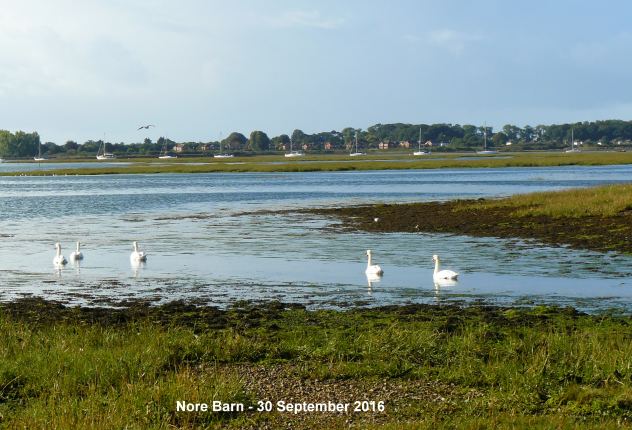
While I was there, I
spoke to Chris Berners-Price who was also looking out
for the Spotted Redshank. I also had a chat with Doug
and Sally over their garden fence. I was able to put
them right about the ducks in the harbour and asked
them to keep an eye out for the Spotted Redshank.
Malcolm's
wet news
Malcolm
Phillips got very wet on Brook Meadow today, but
managed to keep his camera dry to take an interesting
selection of photos. A couple of Bluebottles huddled
together. What is going on? A yellow shelled snail
which I think is a Grove Snail, though I stand to be
corrected. A mature female Common Darter. And a perky
Robin.
Finally, Malcolm saw
yet another Crack Willow live up to its name - this
one is on the path through the south meadow.

THURSDAY
SEPTEMBER 29 - 2016
House
Martin survey
Caroline
French sends what is a final update on her House
Martin survey in Westbourne.
"There was no sign of any House Martins at the nest in
Westbourne today, so I waited and spent half an hour
scanning the sky. I saw just one House Martin flying
high and heading in a southerly direction, so it may
have been on migration. It doesn't necessarily mean
the birds from the nest have departed though - they
may have been feeding elsewhere. Unfortunately, I
don't expect we'll ever know the outcome for those
chicks. If they did all successfully fledge they'll
have quite a challenge ahead of them to reach
sub-Saharan Africa. It has been fascinating to watch
them this summer and I wish them all well! While I was
there I also saw two Swallows feeding overhead, and a
Sparrowhawk."
Finally, Caroline
adds, "I don't have any new photos but I'm attaching a
picture of one of the nests in late August. These
chicks had already fledged but were returning to the
nest sometimes where they would continue to be fed by
adults, and also to roost at night. A large hole
appeared in the nest and through it you can see the
feathered legs and feet of one of the chicks. This was
the second brood in this nest this year."
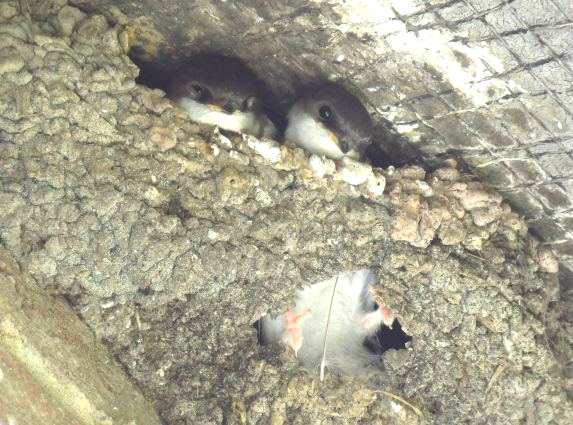
Thanks Caroline for
some fascinating reports and photos. Westbourne is now
securely on my map as a House Martin Mecca!
Mandarin
Duck
Tony Wootton
went down to Peter Pond today where he got a
particularly nice photo of the male Mandarin Duck
which I first saw on Sep 26. As Tony's photo shows,
this bird is not quite in its full splendour, probably
just emerging from its eclipse plumage, but
nevertheless it looks very good. But where has the
female/juvenile got to? This has not been seen or
reported since Sep 21 when Malcolm Phillips got a
photo of it.

Langstone
Mill Pond
Despite the
drizzle, Peter Milinets-Raby visited Langstone Mill
Pond this morning ahead of the incoming tide 9:15am to
10:10am.
"On the fast covering
mud were: 6 Resting Sandwich Tern, 44 Teal (with 23
off Conigar Point), 9 Black-tailed Godwit, Female
Pintail - then flew onto the pond later, 1 Lapwing, 3
Grey Plover, 4 Bar-tailed Godwit, 1 Dunlin, 11
Greenshank (these birds flew off towards Langstone
Harbour over the Hayling Bridge - see note below), 3
Brent Geese, Kingfisher perched on the seaweed posts
by the mill.
On the pond were 6 Teal, an amazing 8 Shoveler, 41
roosting Little Egrets and 2 Grey Heron. Single Grey
Wagtail on the paddock.
After the sun came out I visited Beacon Square (from
1:25pm to 2:40pm - tide slowly dropping): At high tide
there were 2 Sandwich Tern feeding in Emsworth Harbour
and 3 feeding off Beacon Square. A flock of 110+ Brent
Geese were flying over Emsworth Harbour. Roosting out
the high tide off Beacon Square on the salt marsh were
31 Wigeon, 13 Little Egrets and a Great Black-backed
Gull.
Over Thorney Island for 50% of the time I was on site,
an Osprey was circling around.
As the tide dropped from the south in flew two huge
flocks of Curlew (29 & 43), then, in flew 34
Greenshank (presumably from Thorney) to the salt marsh
between Beacon Square and Nore Barn, along with 80+
Redshank and 2 Black-tailed Godwit. It would be
interesting to know where these birds go as the tide
fully drops. I note that 4 Greenshank were seen off
Northney on Going Birding, making the area have a
staggering minimum count of 49 Greenshank.
A Greylag Goose flew east and headed over the village
of Emsworth. As the tide dropped Nore Barn attracted
23 Wigeon and 5 Teal.
Also, a possible Honey Buzzard was mobbed by crows out
of the trees at Nore Barn at 2:15pm and across the
channel to North Hayling - poor views, therefore not
100% certain.
Juniper
Shieldbug
Joyce Sawyer
had this interesting shield bug in her garden
yesterday, which she identified (I think correctly) as
a Juniper Shieldbug. The pinkish-red curved markings
on the corium distinguishes this from other green
shieldbugs.
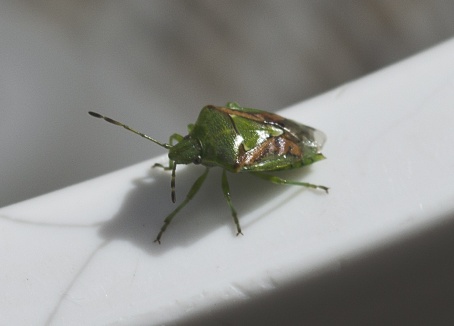
The traditional
foodplant of the Juniper Shieldbug is Juniper, with
the larvae feeding on berries, but in recent years the
bug has started to use Lawson's Cypress. This species
is now common across southern and central England
probably due to the widespread planting of Lawson's
Cypress and is thought to be still expanding its
range.
More
Chiffchaffs
This is
certainly the time of year for seeing Chiffchaffs. In
the last few days, Barrie Jay has had 5 or 6 of them
around his Waterlooville garden mustering, he thinks,
in preparation for migration south. He sends a photo
of one on a Sunflower stem.
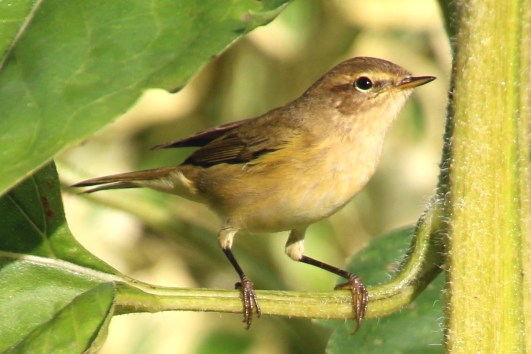
WEDNESDAY
SEPTEMBER 28 - 2016
Brook
Meadow
Malcolm
Phillips spent the morning on the meadow. Among
several photos he sent to me were excellent shots of a
female Blackbird and a Chiffchaff.
Malcolm also got a
photo what I thought looked like one of the micro
moths, but Ralph Hollins and Tony Davis both replied
to say the 'moth' was, in fact, a Caddis Fly.
Ralph added that these flies generally appear at this
time of year. Tony said there were very few caddis
that he can identify from pictures, so we are stuck
with a simple Caddis Fly.
TUESDAY
SEPTEMBER 27 - 2016
Convolvulus
Hawk-moth
Chris Oakley
had a large moth fluttering at his bathroom window
last evening. Being so big it looked like a small bird
banging against the glass. It was still there this
morning, when Chris got this photo. It's obviously in
a very poor condition, but one or two features led
Chris to a Convolvulus Hawk-moth (Agrius
convolvuli). It measures 55mm overall, two
small patches of white can be seen at the base of the
thorax and two eye-like patterns above. The antennae
are held back along the body and are markedly
segmented. I am inclined to agree with Chris on the
ID, though in view of the poor condition of the insect
this must be tentative. Here is Chris's photo on the
left with one from the internet on the right for
comparison.
Convolvulus Hawk-moth
is a migrant in Britain, appearing sometimes in fairly
good numbers. Although larvae are sometimes found in
Britain, usually on bindweed, it does not regularly
breed. It is found throughout Britain, especially in
England and Wales, though is relatively uncommon.
Numbers vary between migration years.
MONDAY
SEPTEMBER 26 - 2016
Perforate
St John's-wort
I cycled up to
the A27 bridge at Lumley this afternoon to have a look
at the Perforate St John's-wort which grows really
well along the edge of the pavement on the bridge.
This is the best site locally that I know for this
attractive plant.

The flowers are now
all gone, but the plants always produce bright red
seed heads which look very attractive in displays. So,
I usually come up at this time of the year to collect
a few stems which last through the winter.
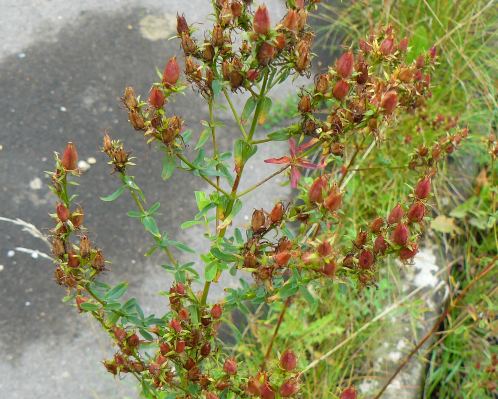
Mandarin
Duck
From the
bridge I cycled back down Lumley Road to have a look
for the Mandarin Duck on Peter Pond that Malcolm
Phillips photographed on Sep 21. When I arrived there
it was standing on the edge of the main raft in the
centre of the pond. But this was clearly a male
Mandarin Duck in partial eclipse plumage. It was quite
different from Malcolm's duck which was thought to be
a juvenile in eclipse plumage. Here are the two
Mandarin Ducks with Malcolm's on the left and today's
male on the right.
I scanned
carefully through all the other ducks on the pond, but
they were all Mallards. However, it is clear that we
have two Mandarin Ducks on the pond. It would be nice
to have a photo of them together.
Michaelmas
Daisies
As I came
along the path leading to Gooseberry Cottage on the
east side of Peter Pond, I stopped to admire the
magnificent swathe of flowering Michaelmas Daisies on
the patch of land south of Gooseberry Cottage owned by
Lillywhite's Garage.
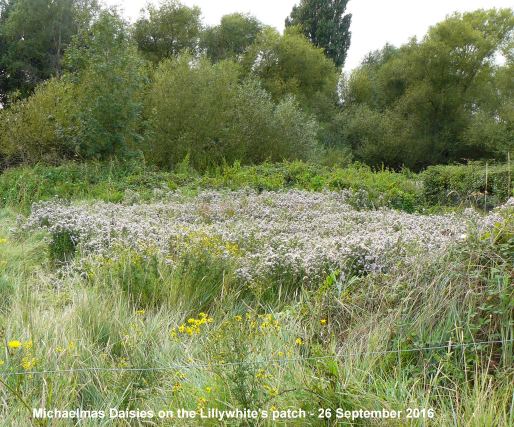
The flowers were
attracting myriads of Bumblebees as well as a Red
Admiral. I think this Bumblebee that I captured is
Bombus pascuorum which is one of the
late flying bees into autumn.
House
Martin survey
Caroline
French concludes her report of the BTO House Martin
survey in Westbourne with a heart-warming story of the
survival of some late chicks.
"Of the 13 nests I have been monitoring, I have seen
no activity at any of the nests since 23rd September.
When I checked again on 25th all was quiet. However, I
was aware of another nest nearby which still had
chicks in it so I decided to keep an eye on it to see
whether the adults continued to feed the young. Sadly,
sometimes House Martins will abandon their unfledged
young to return to Africa.
Yesterday when I went to check on the nest, all I
could hear and see was one chick, which was calling
strongly but unfortunately received no feeding visits
in the 20 minutes I was at the site. Regarding other
House Martins in the area, all I saw was a brief
glimpse of one adult. I concluded, with much sadness,
that this chick was possibly a bit behind its siblings
and had probably been abandoned.
Today I returned just to check whether there was any
activity and was delighted to see an adult delivering
food to the nest. I stayed around to see four feeding
visits in 35 minutes. What's more there turned out to
be two chicks and two adults! I think maybe the strong
winds yesterday perhaps prevented the adults from
finding sufficient food for the chicks. I'm also
unsure about whether one (or even both) of the chicks
had already fledged as I felt sure that there had been
just one chick in the nest yesterday. Chicks do return
to the nest for a while fledging, where the adults
will continue to feed them, although I think these
chicks still look a bit 'babyish' (see photo) and I'm
not sure whether they are old enough to have fledged
or not. Either way, they looked and sounded strong and
healthy today so hopefully have a chance of survival.
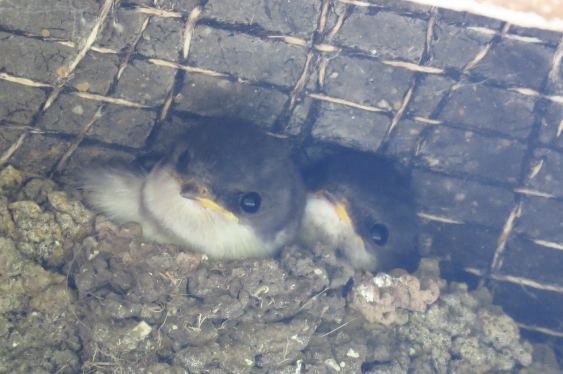
I had a check around
Westbourne and saw no other House Martins at all, so I
think this may be the very last active nest of this
season. I'm at work the next three days and won't be
able to check again until Thursday. While I was there,
a Raven flew over, very low, kronking"
Grass
Snake rescued
Paddy Naylor
had a large Grass Snake, about four feet six inches
long, in her greenhouse in The Rookery. She believed
that it had eaten a large percentage of her garden
pond fish. Subsequently, it reappeared in her
neighbour's garden, stuck in some anti-heron netting.
Its head was caught in the netting as it was trying to
retract itself with a frog in its mouth, a combination
which was too big for the mesh of the net! Paddy was
called to help free it which she did and then took it
onto Brook Meadow to set it free on the banks of the
Lumley Stream. Let's hope it lives well there and
finds somewhere safe to hibernate.
The first photo shows an attempt to hook the snake out
with a stick. The second photo shows part of the
"rescue" team admiring their work. From left to right
are Paddy holding the snake, Max and Sam (the
neighbour's grandchildren) full of pride. Paddy is
quite safe as Grass Snakes are harmless to humans.
Quite an exciting day! Thanks to Neil Jepson for the
report and Paddy's next door neighbour, Mr Long for
the photos.
Unusual
bug
Roy Hay found
this large bug on his curtains yesterday at
Fishbourne. He believes it's a Western Conifer Seed
Bug looking for somewhere to hibernate. See . . .
http://www.britishbugs.org.uk/heteroptera/Coreidae/leptoglossus_occidentalis.html
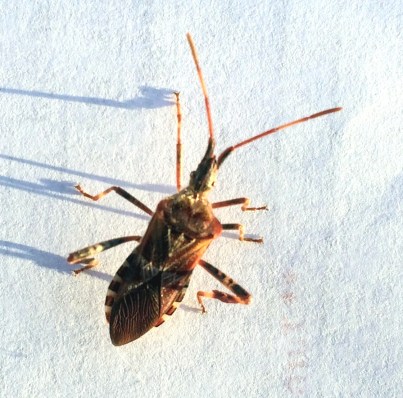
SATURDAY
SEPTEMBER 24 - 2016
Medmerry
On a beautiful
morning with a strong southerly wind blowing Derek and
Heather Mills set off to explore the new RSPB Reserve
at Medmerry. I think they were due to lead the Havant
Wildlife Group but they ended up on their own! Anyway,
they enjoyed the walk and saw lots of birds and their
full report can be seen on the special Havant Wildlife
Group page . . . http://familyfellows.com/hwg-walk-reports-2016.htm
One observation of
Derek and Heather which caught my attention was of
two Bar-headed Geese that came onto the pool at
Medmerry with a Greylag Goose. Here is their photo of
the birds.
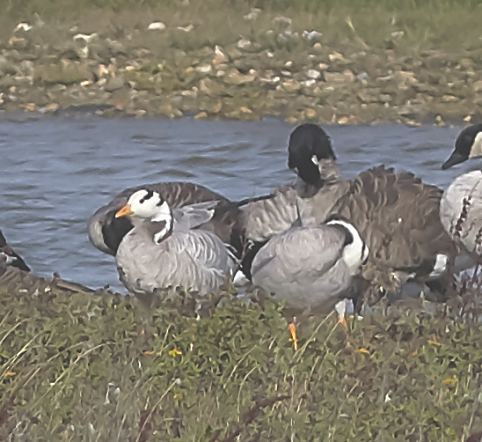
Bar-headed Geese are
popular birds in wildfowl collection and escaped or
feral birds often turn up in small groups, often
associated with other feral birds, like Canada Geese
or Greylag Geese. The Medmerry birds are certainly not
the wild variety that breed in Central Asia and fly
over the Himalayas. They could well be the same birds
that Roy Hay saw at the top of Fishbourne Channel on
May 1st 2013 which were probably from a small flock
that was kept at the Trout Fishing lakes beside the
Hambrook Stream on Priors Leaze Lane in
Southbourne.
I have occasionally seen Bar-headed Geese in Emsworth
- such as on 27 Feb 2007. I used to see a Bar-headed
Goose regularly at Baffins Pond in the 1990s and early
2000s where it was part of the famous 'Baffins Gang'
(composed mainly of 42 Barnacle Geese and 2 Snow
Geese).
FRIDAY
SEPTEMBER 23 - 2016
Brook
Meadow
Malcolm
Phillips went round the meadow today got some
butterfly photos that he put together into an
attractive montage.

Langstone
Mill Pond
Peter
Milinets-Raby visited Langstone Mill Pond this
afternoon (1:15pm to 3:22pm - tide slowly pushing in).
Several people asked Peter if he was Peter
Milinets-Raby, after reading my reports on this blog.
The power of the Internet! Peter also bumped into
Ralph Hollins and had a good chat.
"The other highlights
of the visit were as follows: 2 Ospreys seen
very distantly over Emsworth Harbour and drifted even
further east over Thorney island - They were just
shimmering blobs in the scope: If it wasn't for the
200+ Carrion Crows taking off in one enormous flock
over Conigar Point I would have missed them. That was
at 2pm.
A single juvenile Curlew Sandpiper appeared at
3pm with 9 Dunlin.
Curlew Sandpiper
with Black-tailed Godwits, Grey Plover and
Redshank.
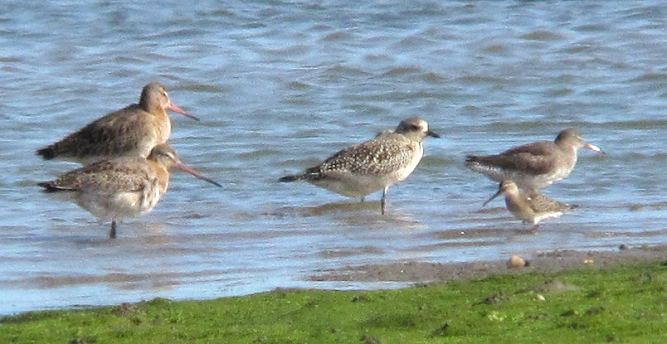
Also on the shore as
the tide pushed in were 1 Bar-tailed Godwit, 10
Greenshank (G//R + YN//- & B//R + LO//- &
RG//- + YY//-), 15 Black-tailed Godwit, 158+ Redshank
(-//B + B//YO & -//B + B//NY), a single Lapwing
and 15 juvenile Grey Plover.
A Kingfisher dashed across the channel and disappeared
onto north Hayling.
Also noted were 10 Sandwich Tern roosting, 8 Common
Gull and 8 Little Egrets with 3 Grey Herons on the
salt marsh.
On the pond were two female Tufted Duck, the female
Pintail (I managed to get fuller details of it's ring
today - Black ring with "10 037" , then AGE written
across the ring from bottom to top - most
peculiar!
Also 27 Teal, 10 roosting Little Egrets, a Grey Heron
and 4 Shoveler."
Deer
at Nore Barn
While sitting
on a bench on the grass area at Nore Barn this
afternoon, Roy Ewing was really surprised to see a
deer burst out of the north wood and shoot off between
walkers, dogs and him to run off westwards. In 24
years in Emsworth this was the first Deer Roy has ever
seen at Nore Barn. Roe Deer are occasionally seen
moving through Brook Meadow, though usually in early
morning, but generally speaking they are pretty mobile
beasts and wander fairly widely.
Here is a shot of
a wandering Roe Deer in the reeds on Thorney Island
taken in 2012.

THURSDAY
SEPTEMBER 22 - 2016
Water
Vole
Malcolm
Phillips had to go to Havant today so had a look down
the river by Tesco's and saw a Water Vole hidden away
in the vegetation. Well spotted, Malcolm.
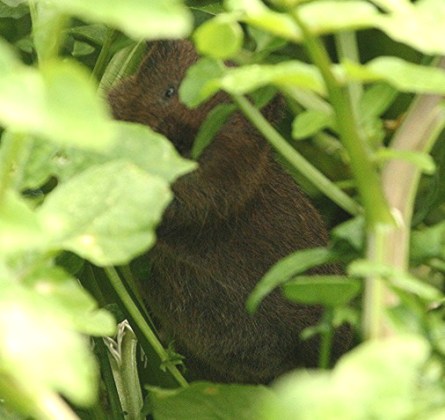
Mystery
duck
I have had
three responses to the query about the mystery duck
that Malcolm Phillips photographed on Peter Pond
yesterday. Ralph Hollins, Tom Bickerton and Peter
Milinets-Raby all agreed that it was a Mandarin Duck
and not a Wood Duck as I surmised. Peter said the
giveaway was the pinkish bill, making it likely to be
a young male in eclipse plumage, brownish head.
Females look greyer.
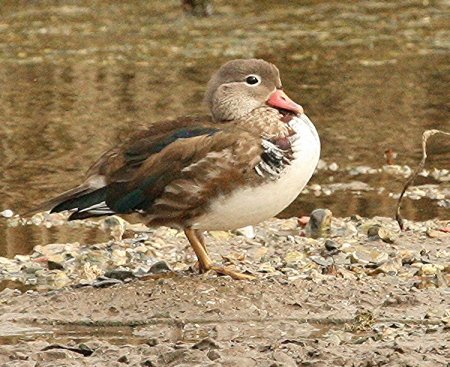
As far as I am aware,
this is the first Mandarin Duck sighting in Emsworth
since a female turned up on Emsworth Millpond in
January 2012. Here is a photo I got of that bird along
with a Mallard for comparison.
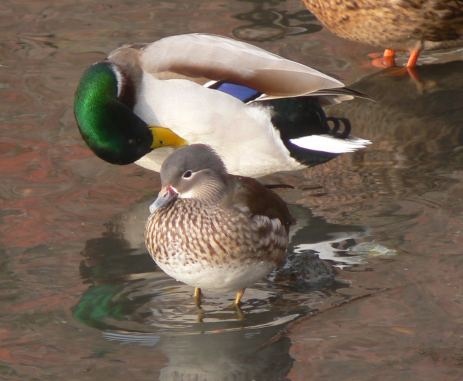
I recall we had a long
staying male Mandarin Duck on Peter Pond many years
ago, not sure when exactly.
Langstone
Mill Pond
Peter
Milinets-Raby popped down to the Langstone Mill Pond
this morning between 9:04am to 9:53am - the tide, was
so low, he could not even see the shore! He reports
.
According to Going Birding, somehow I missed an Osprey
this morning perched on a tree in the horse paddocks
at the bottom of Wade Lane at 9:30am. But all I could
see all morning was a handsome pale juvenile
Buzzard (see photo to show pale juvenile edges to
the wings).

Other birds of note
were, 8 Sandwich Terns roosting, 8 Teal, 5 Common
Gull, 6 Black-tailed Godwits, 3 Meadow Pipits over, 9
Swallows over and 3 Grey Wagtails.
The pond held the female Pintail (fast asleep at the
back and easily overlooked, except for her rings
showing), 11 Teal, 1 Chiffchaff, 3 Stock Doves, 1
Little Egret and 2 Grey Heron. And a Moorhen!
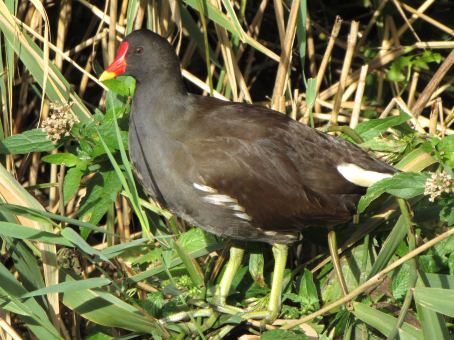
WEDNESDAY
SEPTEMBER 21 - 2016
Malcolm's
news
Malcolm
Phillips got an interesting selection of wildlife
photos from his walk around Brook Meadow and Peter
Pond today. Best of the lot was this one of a Grey
Heron struggling with an Eel. My money is on the
Heron!
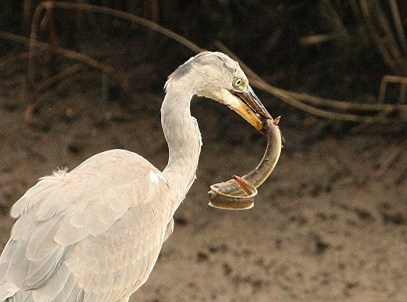
Also, on Peter Pond
Malcolm got this unusual duck which I cannot identify.
It looks a bit like a Wood Duck, probably in
eclipse plumage. Maybe someone can help with this one.
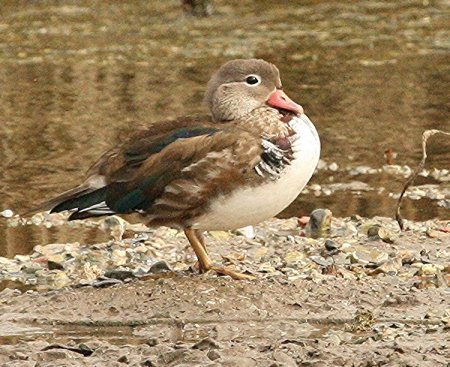
Finally, Malcolm got a
couple of butterflies on the meadow: male Small White
and Peacock.
Ospreys
Christopher
Evans headed over to Nutbourne again this morning but
was unable to park in Farm Lane, as there was a work
party in progress. He continued east on the A259, then
turned down Cot Lane and parked by the first footpath.
He then walked west towards the seawall and just as he
was approaching it, an Osprey flew overhead, then
turned and headed south. It appeared to be holding
something in its talons and was being harried by a
lone gull. Once on the seawall, Christopher spotted a
second Osprey flying over the main channel and
occasionally dipping into the water.
TUESDAY
SEPTEMBER 20 - 2016
Nore
Barn
This morning I
had a walk along the Western Parade shore path to Nore
Barn. Not much on the western mudflats apart from a
few Oystercatchers and a Curlew. At Nore Barn there
was nothing in the stream, but I had my first Wigeon
of the year on the mudflats. I gather there are
already hundreds at Nutbourne.
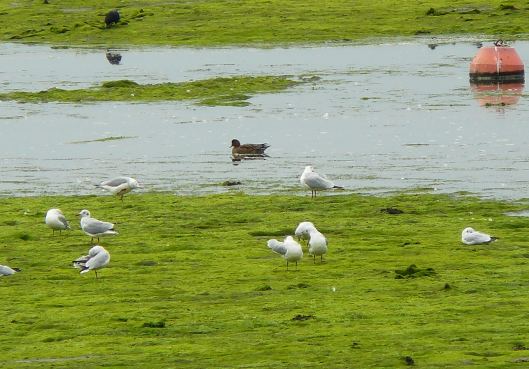
I came back along
Warblington Road where I found a swarm of wasps
feeding on open Ivy flowers.

Emsworth
Harbour
Malcolm
Phillips went down the west bank of Thorney today and
spotted a Great Crested Grebe in the harbour. Always
good to see.
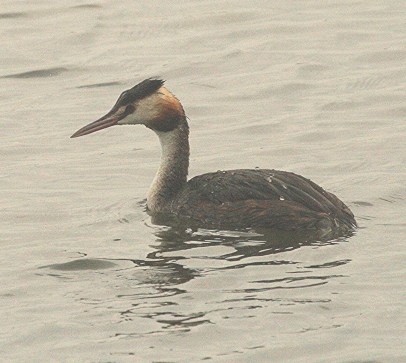
Black-tailed Godwit
and Greenshank were also in the harbour.
Langstone
Mill Pond
Peter
Milinets-Raby popped down to the Langstone Mill Pond
this lunchtime (11:02am to 12:58pm - tide pushing in).
Here is the report.
Some good birds including 2 stunning looking juvenile
Curlew Sandpiper amongst 22 Dunlin, 9 Greenshank
(RG//- +YY//-) amongst 196+ Redshank, 13 Bar-tailed
Godwit feeding with 24 Black-tailed Godwit and 4 Grey
Plover (with a further 4 off Conigar Point).
Resting on the mud were 6 Sandwich Terns, 22 Common
Gulls, 10 Teal. Feeding very close to the sea wall was
a female Pintail.
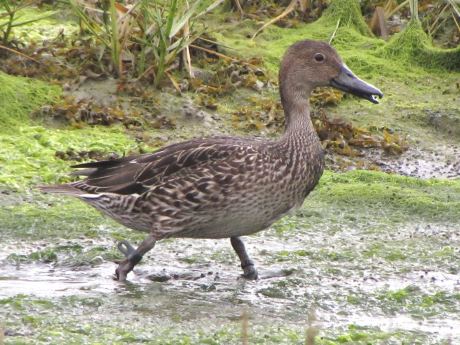
As can be seen from
the photo, it clearly has rings on both legs, with the
one on the left leg having the numbers 037 on a ring
that looks like a bevelled edged nut! The number may
actually begin with a "7" and could be 7037, but from
the 100+ photos I can only guess at. The other ring is
curious, as if it is for tethering with a little "eye"
and I wonder if the bird is of a captive origin? It
flew onto the pond, but vanished when I looked for
it!
Also seen were two flocks of Brent Geese heading west
into Langstone Harbour (32 & 6).
On the pond were 4 female Shoveler and 1 male in
eclipse plumage, along with 10 Teal, 37 Little Egrets,
a Chiffchaff, a Stock Dove and a Grey
Wagtail.

Flying over were 4
Swallows and 85+ House Martins.
MONDAY
SEPTEMBER 19 - 2016
Brook
Meadow
Malcolm
Phillips got a couple of interesting photos today on
the meadow: a female Dark Bush-cricket with a
long curved ovipositor and a snoozing female
Blackbird with what looks like a tick attached to
its face.
Willow
Warbler in garden
Chris Oakley
had this little chap in his garden this afternoon. He
had to photograph it through a window so there is some
reflection, but the image came out quite well.
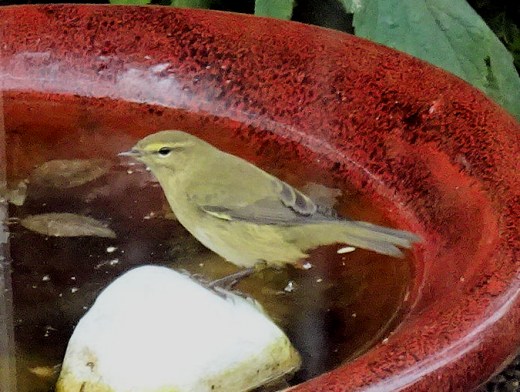
Chris thinks it might
be a Willow Warbler and I am inclined to agree with
him. Certainly the yellow colouring and, in
particular, the bright yellow supercilium suggest
Willow Warbler as opposed to Chiffchaff, which would
be much duller overall. One always looks for a longer
primary projection (ie longer wings) on a Willow
Warbler, though this can't be seen easily in Chris's
photo. This bird would be passing through our area on
its way south, dropping off in Chris's garden for
refreshment.
Mystery
wader
Tony Wootton
added a few more details about the wader that he saw
on the foreshore in front of Southsea Castle
yesterday. He says, the photo was taken on a mobile
phone and hence not very conducive to being enhanced.
It looked Redshank size, with dark legs, a light eye
stripe and the hint of marking on the tail not
dissimilar to Bar-tailed Godwit.
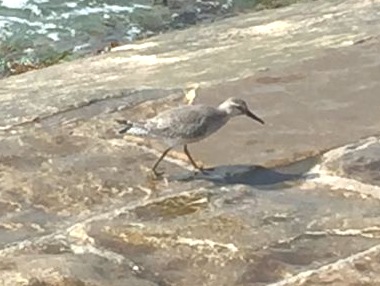
Both Heather Mills and
Peter Milinets-Raby think it is a Knot. Peter says he
remembers one a few winters ago on the rocks by the
castle. I think my vote would also go for a
juvenile Knot though its relatively slim build
is unusual for that bird which is usually quite
chunky. However, the thick bill, dark legs and light
eye stripe certainly indicate Knot.
Other
news
Ralph Hollins
counted a total of 128 Little Egrets coming
into the roost in the trees behind Langstone Mill Pond
last night. This was 4 more than he counted on Aug 25
but noticeably less than the 176 counted on Aug 31 by
Peter Raby, confirming the end of August as the peak
time for the roost and showing that numbers have
already started to head down to their winter low of
around a dozen birds.
Ralph also reported that a flock of 220
Dark-bellied Brent Geese had arrived in
Chichester Harbour yesterday with one Light-bellied
juvenile among them. So, they are here!
SUNDAY
SEPTEMBER 18 - 2016
Nore
Barn
10:30am - I
spent an hour or so watching the tide come in at Nore
Barn this morning. It is still too early for the
Spotted Redshank, but the regular colour-ringed
Greenshank G+GL was present along with another
unringed Greenshank and a small group of a dozen or so
Common Redshank. Here is the Greenshank.
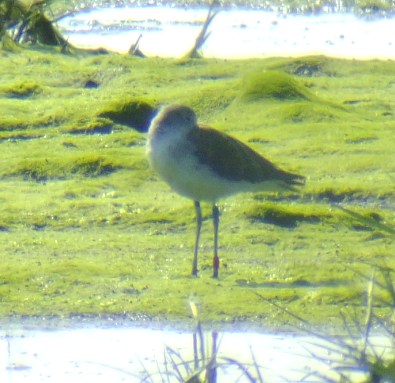
Nothing else apart
from 4 Mute Swans and the usual collection of
Black-headed Gulls. I shall be checking Nore Barn
regularly for the Spotted Redshank - if it comes back
for its 13th winter running. The first sighting last
year was on Sep 27, so there's not long to wait.
Brook
Meadow
Malcolm
Phillips had an hour round the meadow this morning. He
saw a few birds including a very obliging Chiffchaff
of which he managed to get two delightful action
photos. Chiffchaffs are regular summer visitors to
Brook Meadow and will be leaving fairly soon for their
breeding grounds in the Mediterranean Basin. But,
saying that, a few do tend to hang around for the
winter provided it does not get too cold. Alternately,
Malcolm's bird could just be passing through on its
way from somewhere up north.
Mystery
wader at Southsea
Tony Wootton
was down at Southsea Castle today and saw this unusual
wader on the concrete foreshore. What is it? One
expects to see Purple Sandpipers at this location, but
Tony's photo does not look like one of those. The
thick bill, slim body and relatively long legs seem to
rule out most of the common waders. I have seen
Sanderling on this foreshore in the past and Tony's
bird could possibly be a juvenile. It is not easy to
judge size from the photo. I suppose a Ruff is also a
possibility? Does anyone else have any ideas?

Nutbourne
Bay
This
afternoon, Christopher Evans went over to Nutbourne
and walked up to the sea wall from Farm Lane. The tide
was just starting to ebb out and there were a
considerable number of ducks (200-300 - very much a
guesstimate). They were not close enough for
Christopher to identify them properly, but he thought
they were most likely to be Wigeon. In addition there
were 3/4 Crested Grebes and a small flock (10-15) of
Ring Necked Plovers, very well camouflaged by sitting
perfectly still on the shingle. Nutbourne Bay is one
of the best local sites for early migrant ducks,
particularly Wigeon and Teal, and it is good to know
they are arriving.
SATURDAY
SEPTEMBER 17 - 2016
Peter
Pond
I went over to
Peter Pond this afternoon in response to Dan
Mortimer's request for volunteers to help with
dredging the pond which is seriously silting up. Not
that I would be helping with the physical work, of
course; I went just to report and take photos. Dan had
arranged with Nick Medina for the sluice gate at
Slipper Millpond to be left open so that the water in
the two ponds could be drained making the work
possible. When I arrived at about 3pm, Dan and Phil
(from the Brook Meadow volunteers) were working in one
of the narrow pond channels clad in chest high waders
and equipped with rakes and spades. Dan had hoped for
more volunteers.

After a few minutes it
was quite clear that the work was beyond them due to
the depth of the mud and difficulty in digging it out.
So, they called a halt and Dan's wife, Becky, kindly
invited us into their house (with the pebbly front
garden) for a cup of tea. In the meantime, David
Gattrell arrived and lost no time to get out onto the
pond where we found him raking up the mud in a very
accomplished manner.
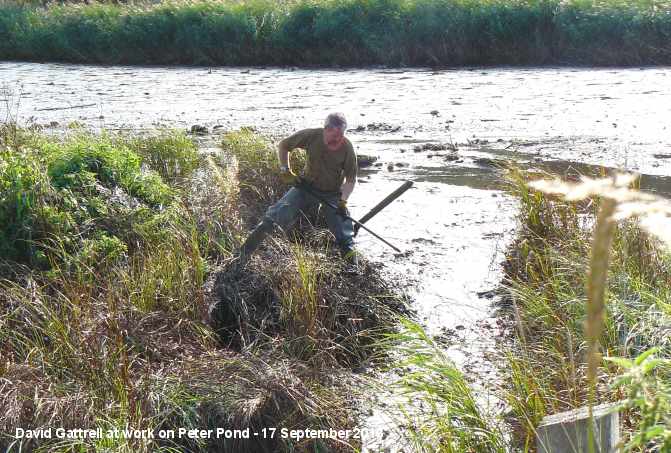
David has been
managing the pond for as long as I can recall and
recently had created, single-handedly, numerous new
channels. So he knows the pond well and how best to
work on it. It will be interesting to see how the work
progresses over the next few months, though it seems
to me that mechanical help will be needed to have any
serious effect on the amount of silt in the pond.
Tube
worms
Low water in
the two Hermitage ponds provides a good opportunity to
view the numerous coral-like growths left by the
tubeworms that live in the ponds.
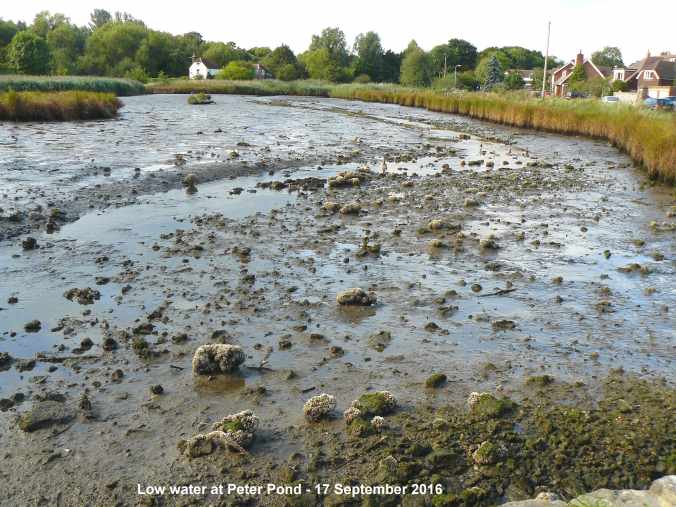
These creatures are
specific to coastal brackish lagoons like Slipper
Millpond and Peter Pond and are, as a consequence,
ecologically important. The growths on the two ponds
are produced by the Bristle Worm (Ficopomatus
enigmaticus), which plays a very significant
role in the economy of the ponds' eco-systems. The
aggregated tubes of the Bristle Worm provide not only
an additional habitat for other organisms but their
presence is beneficial for the ponds as a whole.
Thorney
Deeps
Heather Mills
reported on this morning's walk to Thorney Little
Deeps. They dipped on the Red-necked Phalarope, but
got good views of Whimbrel in the harbour and a
Redstart on the bushes.
For the full report go
to . . . http://familyfellows.com/hwg-walk-reports-2016.htm
FRIDAY
SEPTEMBER 16 - 2016
Extra
long Trout
Today, Malcolm
Phillips got a photo of an unusual fish in the pool
between the two bridges to the north of Peter Pond,
which I usually refer to as the Lumley Pool. The fish
had orange spots on its flanks characteristic of a
Brown Trout, but it was much longer than any Trout
either of us had ever seen before. I gather Trout can
vary quite a lot in size and colour, but this seems an
exceptionally large one. Can anyone throw any light on
this creature?
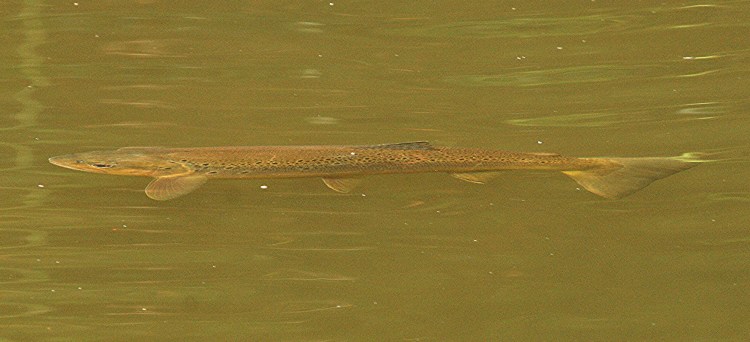
Knopper
galls galore
This autumn
Chris Oakley has noticed an enormous increase in
Knopper galls on the grass around the two large oaks
outside his house. He says, "There are thousands of
them, so many it was difficult to find even one
uninfected acorn. One of my photos shows the hard
egg-like structure which holds the larva. Incidentally
these galls are extremely hard to cut into, it feels
like compressed wood. The cycle of the gall wasp,
Andricus quercuscalicis, is well known
but I was surprised to learn that it was only
introduced into this country in the 1950's. Whether
such an infestation will have any long term affect on
the oak tree, it would be difficult to
tell."
I have not noticed any
increase in Knopper Galls this year. Has anyone else
noticed this or is the problem just with Chris's
trees?
THURSDAY
SEPTEMBER 15 - 2016
Waysides
News
I got my old
bike out this morning to have a tour around some of
the local waysides. Unfortunately, much of the the
initial drive and enthusiasm has gone out of the
Emsworth waysides project, but personally, I still
love going round to check on some of my 'old friends'
that I got to know well in the early days.
Starting at the Emsworth Recreation Ground I found the
nice area of grassland behind the bowling green has
been cut, but ominously the Blackthorn scrub
continues its relentless march and in a few years will
totally cover this attractive area.
What I think are Narrow-leaved Michaelmas
Daisies are still growing by the northern fence in
Emsworth Recreation Ground, but not yet in flower.
This is one of the many hybrid species of Michaelmas
Daisies that were originally introduced from North
America. It has whitish flowers and narrow leaves,
hence the name.

I was pleasantly
surprised to see a good growth of several Wild
Clary plants on the council verge in Christopher
Way, some with tiny flowers showing. Grid Ref: SU
74888 06917. This plant just keeps going despite being
relentlessly mown by the council cutters. Maybe the
cutting is good for it, which may account for its
disappearance from the official uncut wayside a little
further towards New Brighton Road.
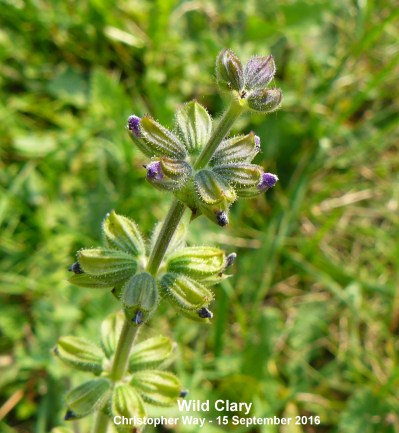
Onto the Westbourne
Open Space at the top of Westbourne Avenue which is a
lovely wilderness of grasses.
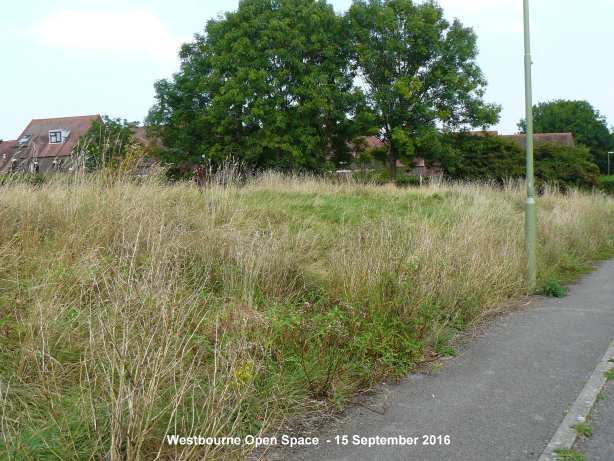
There are also and
some flowers, including Common Ragwort and
Amphibious Bistort (not in flower) the presence
of which on this dry inland site is a bit puzzling.
Back to the New
Brighton Road Junction where I picked some Stone
Parsley for my desk display. Not a pleasant
smelling plant, but I love its delicate white flowers.
Not good for photography.
Finally, I had a quick
look at the Railway Wayside where the plants on the
embankment are seeding profusely, particularly the
Willowherbs.
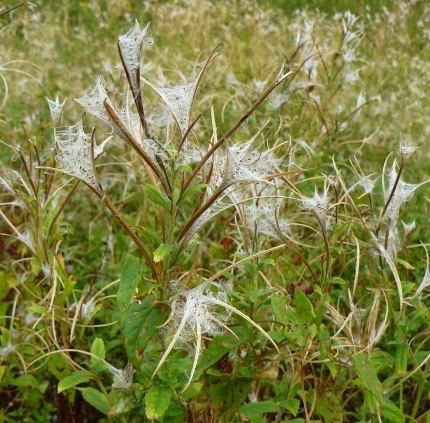
There is also a nice
show of Canadian Goldenrod which can be viewed
from the north entrance to the station.

I climbed through the
bars to have a look at an apple tree which is
loaded with fruit. I tried one, but the apples are
small, hard and not very tasteful. Maybe they will
ripen.
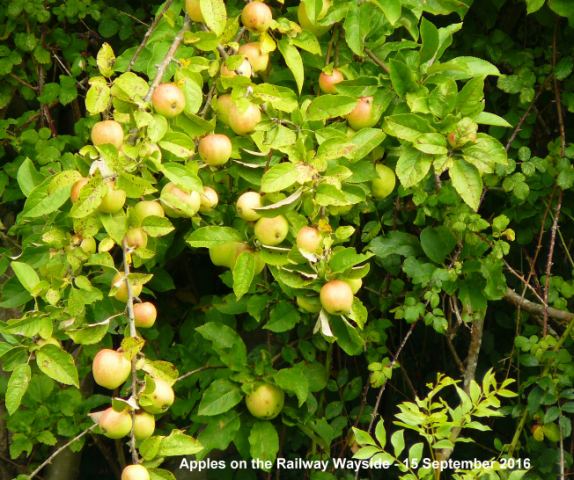
Greater
Burdock (Articium lappa)
Finally, I cut
back to Washington Road to have a look at the Greater
Burdock that has had a very good growing season just
before the entrance to Emsworth Recreation Ground.

The plants are now
covered with their hooked fruits - the burrs - which
cling tenaciously to any clothing, or even flesh, as I
discovered when I tried to remove some of them for
closer study. This is the plant's strategy to disperse
seeds, though most of the seeds on the Emsworth plants
don't travel far, so the colony is fairly static on
the grass verge by the pony field.
When I got home I cut one of the burrs open to reveal
a cluster of small oval seeds with a plume of whitish
hairs at one end.
Here is a close-up shot of one of the burrs showing
the hooked bristles at the end of the bracts (left)
and one of the seeds magnified 20 times (right).
I was interested to
read that although Lesser Burdock is classified as a
native plant in Britain, the status of Greater Burdock
is less certain. Greater Burdock is usually classified
as an archaeophyte - an ancient introduction before
1500 AD, though Stace and Crawley argue that it is one
of the strongest contenders for native status, along
with Wild Leek and Wild Turnip. These are 'denizens'
or 'would be natives' which have "achieved a good
foothold in our flora having entered closed,
semi-natural communities so that they often appear to
be native". Reference: 'Alien Plants' by Clive Stace
and Michael Crawley.
Brook
Meadow
Malcolm
Phillips did not have much time on the meadow today,
but managed to get this very nice image of a Bumblebee
feeding on a Common Fleabane flower. This looks like
Bombus pascuorum which is one of the
bees that typically fly late into autumn. I also saw a
good number of these small ginger Bumblebees during my
walk around the waysides today.
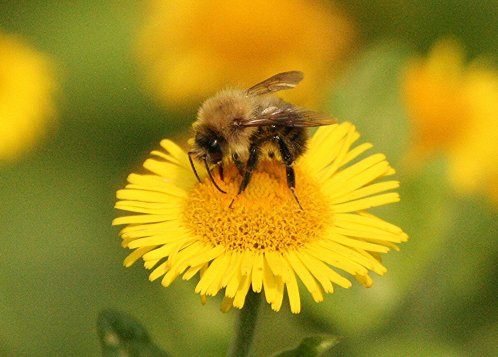
Mystery
'fly'
Ralph Hollins
consulted an expert about Malcolm's photo of what
looked like a fly on Brook Meadow on September 3.
Ralph's expert thought the most likely identification
is that it is a waterlogged Tree Bumblebee
(Bombus hypnorum). I found this quite
surprising as the insect looks really black and most
un-bee-like.
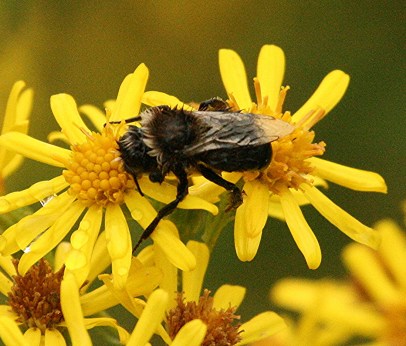
Ralph adds "with Ivy
starting to flower in Langstone yesterday there should
be a lot more opportunities for photographing
insects."
WEDNESDAY
SEPTEMBER 14 - 2016
Russian
Vine
Russian Vine,
sometimes known as 'Mile-a-minute' because of its
prodigious growth rate, completely covers the hedge at
the bottom of Seagull Lane opposite the entrance gate
to Brook Meadow as it does every year. It is a
vigorous climbing perennial with vine-like stems from
which hang attractive trusses of bright white flowers.
Russian Vine is an alien plant introduced into British
gardens from Central Asia in about 1894 and first
recorded in the wild in 1936 (the year I was born!),
but, I gather, has not become fully naturalised away
from gardens. This photo does not do the plant
justice. It should be seen.
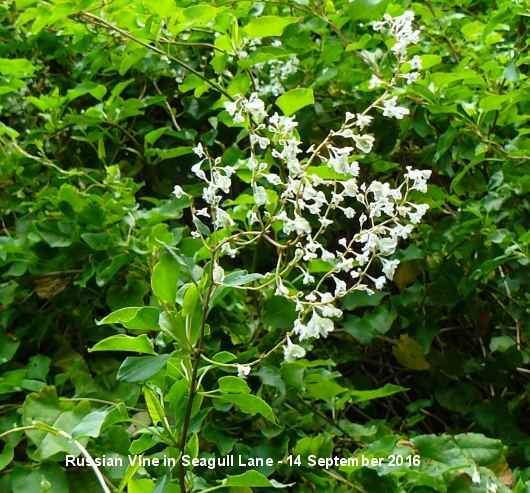
Unlike Japanese
Knotweed, with which it is often compared, Russian
Vine is not a subterranean-spreading plant but is a
climbing woody plant without rhizomes. Apparently, it
can hybridise with Japanese Knotweed to produce what
is called Fallopia x conollyana (or
Conolly's Knotweed). Wow, that must be some plant!
Reference: 'Alien Plants' by Clive Stace and Michael
Crawley.
Slow-worms
I found
another Slow-worm under one of the black felt mats
that the ecologists have scattered around the meadow
as part of their reptile survey. This one was plain
and unmarked with no dark stripe which presumably
means it is a male. The one Brian Lawrence had a
couple of days ago on Brook Meadow was almost
certainly a female with a line down its back.
For
comparison, Brian's female is on the left and my male
is on the right
Ralph Hollins also had
one in his Havant garden which prompted him to search
out a useful reference to these delightful creatures
at . . . http://www.arkive.org/slow-worm/anguis-fragilis/
The scientific name
Anguis fragilis means 'fragile snake',
and refers to the ability of this lizard to shed its
tail when seized; the tail may continue to wriggle
after being shed, and can distract predators while the
slow worm itself escapes. A new tail begins to
regenerate after a couple of weeks.
In the United Kingdom, the Slow-worm is protected
under Schedule 5 of the Wildlife and Countryside Act
(1981). Under this act, it is illegal to kill, injure,
and sell individuals of this species.
Common
Reeds
Common Reeds
must be one of the most graceful plants at this time
of the year with their purple-tinged nodding
spikelets. My favourite place to see them locally is
the west side of Peter Pond along the path leading to
Gooseberry Cottage where you usually have to push your
way through the flowers. Today, I snipped off a few
stems for my desk wild flower display where they will
last through the winter.
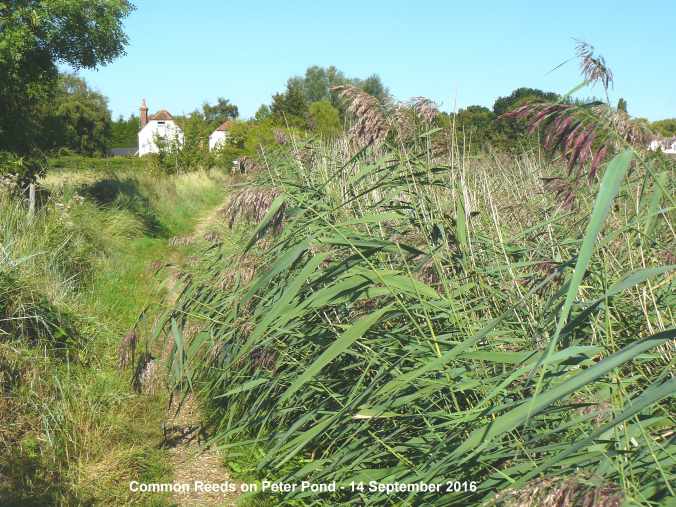
Titchfield
Haven
Malcolm
Phillips made his first ever visit to Titchfield Haven
today. He came away with a batch of photos of which I
have selected the following for this blog:
A juvenile Sandwich Tern - waiting for its
first ever long migration to West Africa.
A Common Snipe - belly deep in water, probing
the muddy floor with its long bill.
TUESDAY
SEPTEMBER 13 - 2016
Brook
Meadow
Malcolm
Phillips got a good selection of photos from today's
walk around the meadow.
I found the Crane-fly the most interesting of
Malcolm's photos. This insect, often referred to as
'Daddy-long-legs', is a very common sight at this time
of the year as it blunders around the vegetation with
its seemingly ungainly long legs.
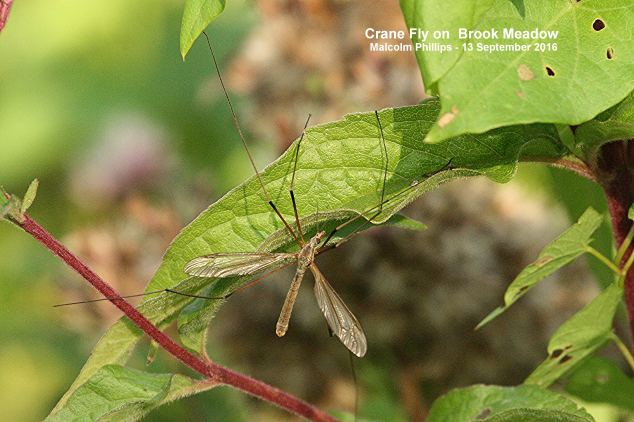
From the wing pattern
on Malcolm's photo (brown along the front with brown
stigma, but otherwise plain) my guess is that this
specimen is Tipula oleracea, described
by Chinery as one of the commonest species of
Cranefly. The other common insect usually described as
a 'Daddy-long-legs' is the Harvestman, though this is
more like a spider with 8 legs, though apparently
isn't.
Malcolm also got a
female Long-winged Conehead which has with long
wings and a long ovipositor and a Meadow
Grasshopper with very short wings, the only
flightless grasshopper in Britain.
Finally, two more very
common creatures on Brook Meadow at present. A male
Common Darter and a Garden Spider.
MONDAY
SEPTEMBER 12 - 2016
Brook
Meadow
Malcolm
Phillips only managed half an hour on the meadow
today, but got cracking photos of two of our colourful
resident birds.
Brian Lawrence was
also on the meadow this afternoon. He lifted one or
two mats and found some Slow-worms.
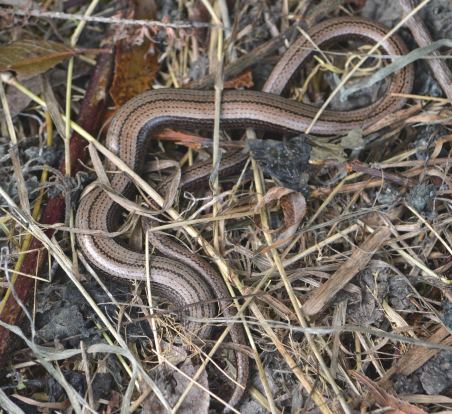
Langstone
to Thorney Island
Peter
Milinets-Raby had a morning free so spent it as he
says 'going everywhere' - from Langstone to Thorney
Island.
9:16am to 9:50am - Langstone Mill Pond:
3 Shoveler, 33 Teal, 24 Collared Dove, 41+ Swallow
heading south east, 2 roosting Little Egrets and 2
roosting Grey Heron.
Off shore on the small clump of salt marsh roosting
out the low hide tide (only 3.8 metres) were 113+
Redshank, 10 Greenshank, a Shelduck and 3 Sandwich
Tern.
10am to 11:00am - Emsworth Harbour - tide beginning to
drop . . . slowly.
12+ Swallows heading south east, 1 Common Tern, 1
Sandwich Tern, 1 lonely Brent Goose and 2 Meadow Pipit
over. 41 Turnstone roosting on a yacht, 2 Cormorants,
3 Little Egrets, 1 Coot & 2 Mute Swan on Emsworth
Pond.
23 Grey Plover, 12 Dunlin, 4 Ringed Plover, 2
Bar-tailed Godwit, Redshank 80+ (ringed bird -//O +
O//WB), 9 Black-tailed Godwit, 1 Shelduck, 2
Greenshank (G//R + WY//- and B//R +GY//-).
Beacon Square (11:04am to 11:48am):
4 Black-tailed Godwit, 3 Dunlin, 6 Bar-tailed Godwit,
Marsh Harrier - female - took off from marsh at
11:10am, circled around, then headed towards Hayling
Bridge. 2 Wheatear (see photo).

Redshank 80+ (one with
colour rings - -//G + G//BR - This is a new
combination, not seen this before - a recent catch?)
Greenshank 12 (including a distant one at Nore Barn -
So a total of 24 seen today!)
With visa, passport
and inoculations in hand I crossed the border and
visited the Little Deeps on Thorney Island 11:58am to
1pm (No-one around, had the place to myself which I
love!!). Red- necked Phalarope seen with ease
along with Chiffchaff 1, 2+ Cetti's Warbler, 4 Little
Grebe, 3 Tufted Duck, 27 Teal, 1 Gadwall, Water Rail
heard, Kingfisher heard, 10 Yellow Wagtails over.
Pete needed to lie
down after all that dashing around, travelling miles
to a far off foreign land!
Thanks
for the photo Peter
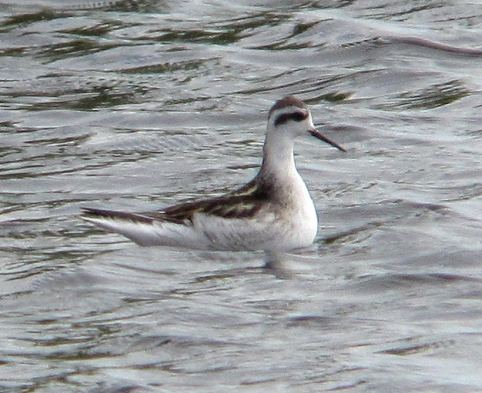
Note
on Red-necked Phalarope - It breeds in the Arctic
on coastal wet tundra and winters on the Atlantic
Ocean off S and W Africa via migration routes in the
north Atlantic. In Europe it is a rare migrant but is
regularly seen in singles or small groups from Sep-Oct
close in shore or on coastal lagoons as on Thorney
Deeps.
Farlington
Marshes
Mike Wells had
a wander around Farlington Marshes this morning hoping
to get a shot of an Osprey seen recently. No Osprey,
but an abundance of Wheatear, Goldfinches and
Starlings by the thousand! Mike attached photos of a
Black-tailed Godwit having a 'spruce-up'
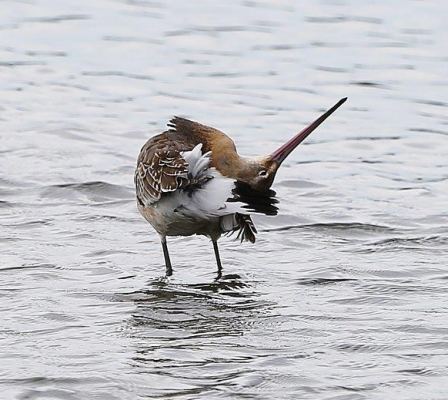
Miie also got a photo
of Seals on the mudflats, with a selection of colours!
They are probably all Harbour Seals which can be
brown, tan, or grey,

Mike also saw a number
of very poorly rabbits, one being blind and deaf, but
still eating.
SUNDAY
SEPTEMBER 11 - 2016
Japanese
Knotweed
While I was
walking along the footpath behind Lillywhite's Garage
(which incidentally is very overgrown) I noticed a
Japanese Knotweed plant in full flower. Its sprays of
white flowers are certainly attractive, but the plant
has a notorious reputation for spreading vegetatively
by underground rhizomes, which are strong enough to
push through tarmac and damage built structures
(including houses). It is not quite a Trifid, but is
often viewed in the same light.

Now for a few facts.
All the Japanese Knotweed plants in Britain are
female, possibly originating from just a few clones,
so seed formation does not occur. This means that
removing flowers does not affect the plant or its
ability to spread. Also, small sections of roots can
quickly grow into plants, so there is no point in just
pulling them up, as this will just create more plants.
Getting rid of the plants is far more difficult and a
whole industry has now developed to tackle this
problem.
Actually, the plants on the Lillywhite's path have
been there for some years and have not spread and are
not really any threat as they are well away from
houses. So, maybe we can just enjoy them!
From a wildlife point of view Japanese Knotweed can be
said to be an extremely successful alien introduction.
It was brought to England from Japan in the early 19th
Century as a prized garden plant. It became
established in the wild by 1886 and has gone from
strength to strength since then!
Brook
Meadow
Malcolm
Phillips only did a once round the meadow today, but
did see the Pike again just up from the south
bridge.

and a couple of
birds.
Warblington
shore
Peter
Milinets-Raby popped down to the Warblington shore
this morning, hoping that the tide would drop, but it
took ages (8:34am to 10:24am).
Hedgerow behind Conigar Point: Very little migration
noted this morning except for 55+ Goldfinch, a male
Blackcap and a Whitethroat.
Conigar Point: 3 Grey Plover, 2 Mute Swan, 13
Bar-tailed Godwit, 1 Common Tern, 3 Little Egret, 4
Greenshank (two colour ringed - G//R + GO//- and GR//-
+ YY//- ), 6 Yellow Wagtails over (4 seen, 2 heard), 2
Ringed Plover, 2 Lesser Black-backed Gulls, 1 Sandwich
Tern.
Tamarisk Hedge: 1 Willow Warbler, 3 Chiffchaff.
Off Pook Lane: (Photo of sea damage - getting worse
from photos taken earlier in the year)
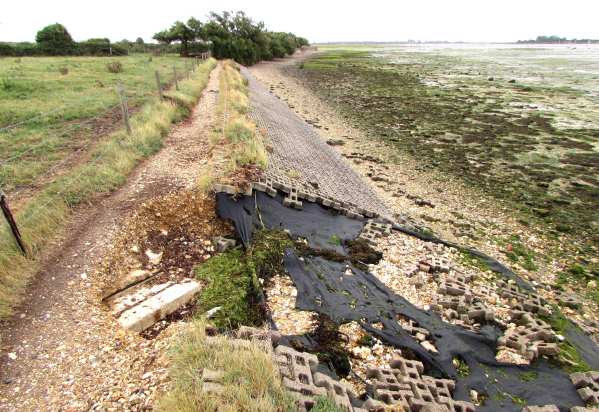
4 Greenshank (NR//- +
YY//-), 4 Black-tailed Godwit, 1 Bar-tailed Godwit, 1
Whitethroat, 3 Stock Doves, 1 Jay.
Also find attached an interesting coloured horse fly
species I saw for ten seconds eating blackberries
before it buzzed off. Any ideas?
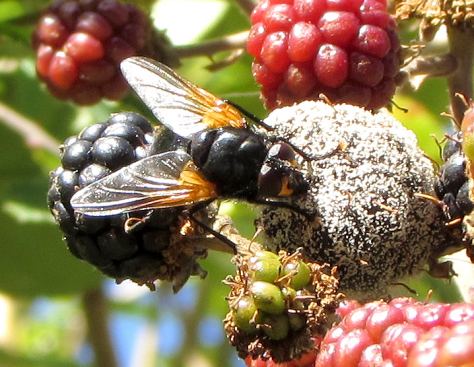
Rare
bird on Thorney
There has been
a juvenile Red-necked Phalarope on the Little
Deeps, Thorney for several days. Ros Norton saw it
this afternoon from the footpath and it was easy to
see and looks like a small gull. Can someone get a
photo of the bird?
Look out also for Ospreys fishing in the
harbour on the eastern side of Thorney Island.
SATURDAY
SEPTEMBER 10 - 2016
Canary
in the garden
For the past
three days we have had a small yellow bird in the
garden, sometimes feeding with others. It looks very
much like a Domestic Canary, which has presumably
escaped from someone's aviary. Today, I managed to get
a photo of it feeding with a young Robin on the grass.
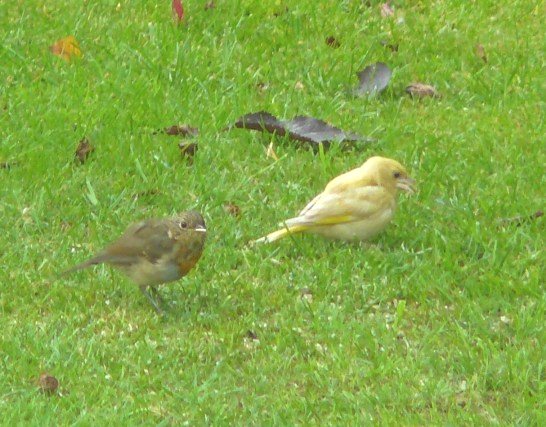
It clearly has
identified our garden as being a good source of food.
However, Domestic Canaries are specially bred to live
in cages and lack the natural defensive strategies of
wild birds. Hence, they generally don't last long in
the wild, as they are very vulnerable to predators of
all sorts. They derive from the wild Canary which
breeds in Madeira and the Canary Islands.
FRIDAY
SEPTEMBER 9 - 2016
Reptile
Survey
On this
morning's walk through Brook Meadow I was pleased to
meet up with Jack, a member of CSA, the Ecology firm,
which is carrying out the reptile survey on Brook
Meadow. Jack was checking the black mats that had been
scattered around the meadow for any reptiles which
might be hiding beneath them.
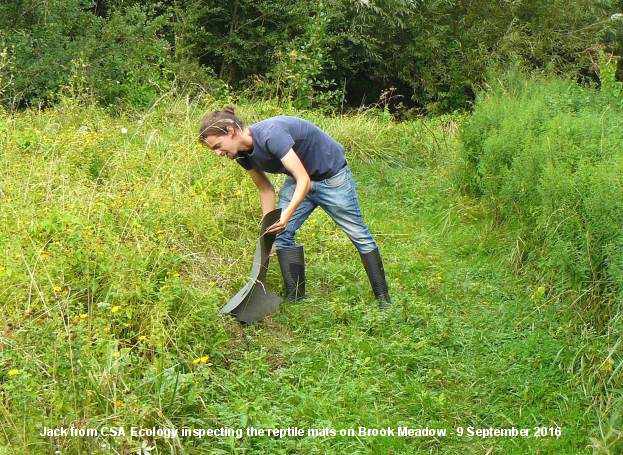
He said he had already
found a good number of Slow-worms under the mats,
mainly in the north west sector of the meadow which is
a 'hot spot' for them. They included males, females
and juveniles. Jack explained how to distinguish
between male and female Slow-worms. When Slow-worms
are born they all have black flanks which are kept in
females as they mature, but not in males, which always
have clear flanks. Here is a young/female Slow-worm
with dark flanks taken by Maurice Lillie on Brook
Meadow in 2010.

Jack said he had not
found any Common Lizards, which I was not surprised at
as we have had no sightings of them at all this
summer, despite seeing lots the previous summer.
CSA, the ecology firm who organised reptile
translocation on to the Meadow last summer, are
required to re-survey the site a year later to
determine how many reptiles have survived. They do
this by a sampling method in which black mats are
distributed around the site; the mats generate heat
underneath which attracts the reptiles. The count
reveals the rough percentage of survivors still
present. Whether to carry out further relocations will
depend on the results of the survey.
Malcolm's
news
Malcolm
Phillips was only on Brook Meadow for an hour this
afternoon, but long enough to get some interesting
wildlife images. Malcolm got very excited when he saw
this fellow swimming in the river, hoping it might be
a Water Vole. However, close inspection of the photo
clearly shows the long body, long ears and pointed
nose characteristic of a Brown Rat.
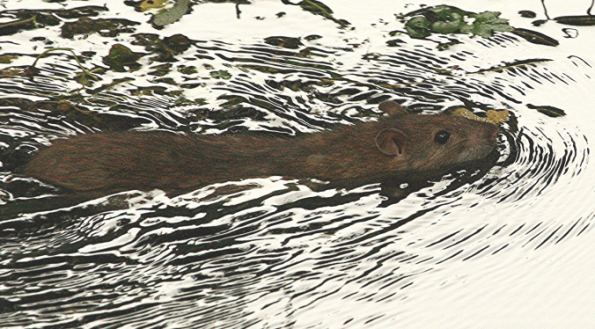
Malcolm also got a
nice shot of a Blackbird consuming red berries
on our Rowan trees on the east side of the north
meadow. Please leave some for the Waxwings!
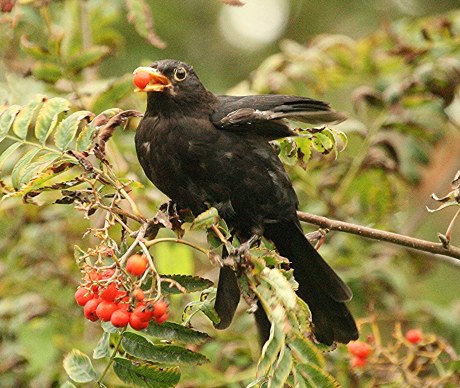
Finally, Malcolm got
photos of a splendid Painted Lady (not very
common this year) and a Red Admiral (also not
as common as usual).
Langstone
Mill Pond
Peter
Milinets-Raby popped down to the Langstone Mill Pond
late in the morning (11:43am to 12:54pm - low tide).
Main observations: Off shore by the pub were a lovely
selection of waders and gulls and terns.
6 Ringed Plover, 9 Dunlin, 134+ loafing Redshank, 3
Greenshank (2 distantly on Conigar Point), 7 Common
Gull, 1 Knot, 1 Black-tailed Godwit, 7 Sandwich Tern
resting, 1 Grey Plover.
Then at noon, everything took to the air calling and
screeching. About a minute later in drifted an
Osprey over my head from the Southmoor direction.
It drifted over to Conigar Point where it circled
around for five minutes, looking for fish. With no
luck, it then gained height and then drifted east to
Thorney Island. After this appearance,, there was
nothing on the mud!
On the pond were 3 male eclipse Shoveler (see photo)
and one female eclipse Shoveler, 21 eclipse Teal.
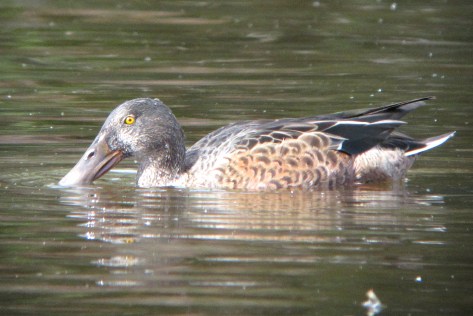
10 roosting Little
Egrets (one juvenile was washing close to the path -
see photo)
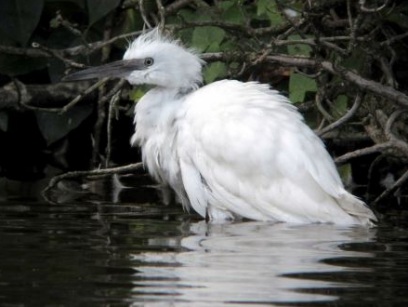
Yellow Wagtail heard
flying over. Nothing in the horse paddock because of
Buzzard perched on post - (see
photo)
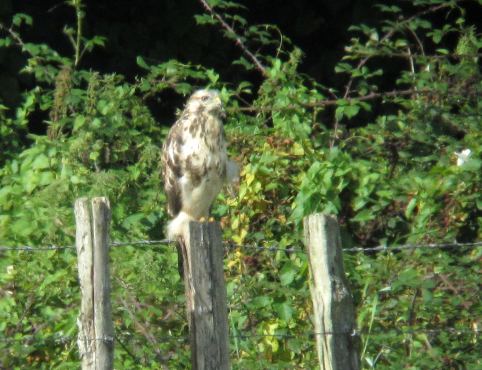
WEDNESDAY
SEPTEMBER 7 - 2016
Brook
Meadow
It was hot and
humid for this morning's walk through Brook Meadow. I
met Malcolm Phillips who had already been on the
meadow for 2 hours when I arrived. He thought he may
have seen a Water Rail in the river near the
S-bend, but did not get a photo. This would be a first
for the year on the meadow. I too saw something
scurrying quickly along the river bank, which I put
down as a Moorhen, though I did not see it clearly
either.
As usual, Malcolm got some excellent photos of
butterflies. His best one was a Clouded Yellow
which he also managed to capture in flight. I have
yet to see one at all this year.
Malcolm also got
female Common Blue (blue form) and Small Copper.
Malcolm photographed
what must be a 4-spot spider (Araneus
quadratus) with a rounded abdomen like that
though the spots are not visible. Here it is with its
prey neatly wrapped up. It could be a grasshopper?
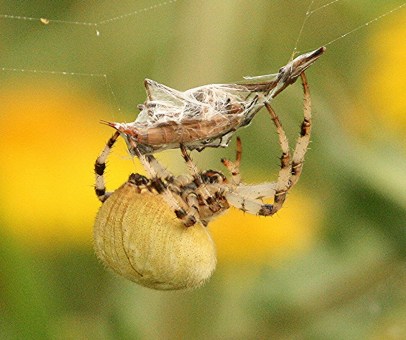
Malcolm told me he
would be leaving Emsworth for good in about 4-5 weeks
time to get his papers sorted out for his permanent
move to Cuba. We shall certainly miss him as he has
made a significant contribution to wildlife recording
over the 5 years he has been visiting Brook Meadow. He
has also left me with a fine gallery of wildlife
photos.
While walking through
the orchid area I saw a small blue butterfly feeding
on Common Fleabane which I assumed at first was a
Common Blue until I examined it more closely. The
black dots on its underwings clearly indicated it was
a Holly Blue which I usually associate with Ivy
bushes and flying high.

The only other photo I
got was of what I think was a female Long-winged
Conehead though I did not get a good enough view
to confirm the identification. I think the insect has
wings, if not it would be a Short-winged Conehead.

Here are much better
pics of both Long-winged Conehead (left) and
Short-winged Conehead (right)
taken on in previous years. Only females have a long
ovipositor.
Langstone
Christopher
Evans was down at the Broadmarsh slipway this
afternoon and got a shot of a Black Swan that
he also saw last Thursday. It was with the usual
gaggle of Mute Swans to be seen in that location - 34,
at a quick count. I wonder where this has come from?
Meanwhile, the Langstone swan family were on
the millpond this afternoon. Christopher didn't manage
a group photo but got a shot showing six cygnets and
one adult.
Shield
Bugs
Eric Eddles
saw these bugs yesterday, a mixture of adults and
immatures, which he says are Dock Leaf bugs -
Coreus marginatus. These shield bugs do
gather in large numbers at this time of the
year.
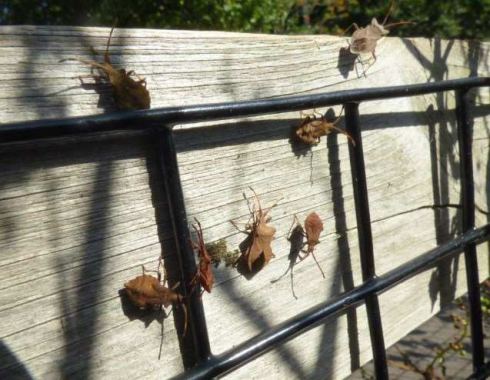
TUESDAY
SEPTEMBER 6 - 2016
Malcolm's
news
Malcolm
Phillips got a few photos on Brook Meadow today, one
of which, he says, was "a bit sad". Malcolm was just
about to get a shot of a Small Copper when it flew
into a spider's web. There was no escape as he watched
it being wrapped up by the spider.
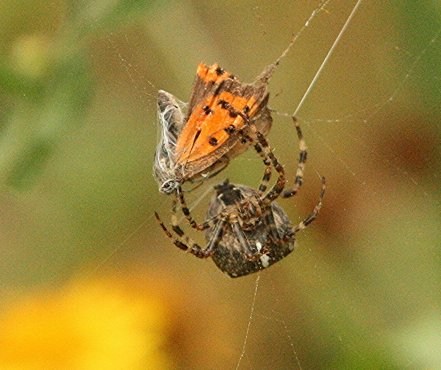
Other than that there
were plenty of bumblebees and flies taking advantage
of the abundant nectar source provided by the late
summer flowers.
MONDAY
SEPTEMBER 5 - 2016
Pike
returns
Malcolm
Phillips was on the meadow for a while this afternoon
and spotted a Pike in the river just north of the
south bridge which he estimated to be a good 18ins
long. Not easy to see even in this photo, so well
spotted Malcolm.
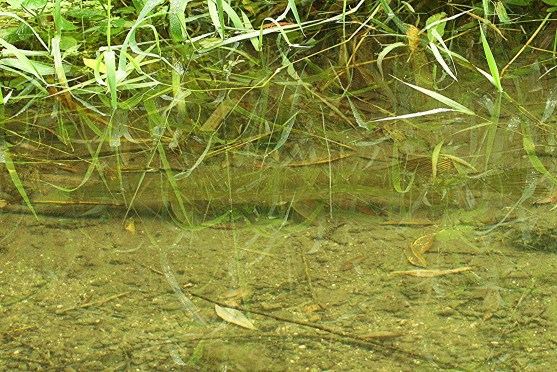
This was the first
Pike sighting we have had on Brook Meadow this year
and, in fact, the first since October 2015. I must
admit hoping we had seen the last of these large and
fierce predators in the river which we suspect could
have contributed to the disappearance of our Water
Voles.
Turtle
Dove in garden
Leslie Winter
was very surprised to have this rather sorry looking,
but distinctive, Turtle Dove in his garden this
morning.
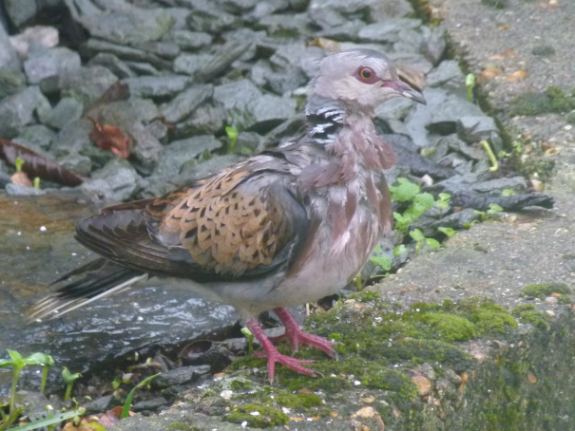
As we all know, Turtle
Doves are on the red data list of endangered birds
with numbers having plummeted over the past 30 years
or so. This bird which is probably undergoing its
moult is no doubt taking a breather on its way back to
its wintering grounds in tropical Africa, but its
chances of getting there past the shooters of Malta
are not good.
Leslie's sighting reminded me of my one and only
garden sighting of a Turtle Dove in my own garden in
Bridge Road Emsworth in June 2005.

SATURDAY
SEPTEMBER 3 - 2016
Brook
Meadow
Malcolm
Phillips sent an interesting set of photos from his
walk around the meadow today. A friendly robin waiting
patiently. A Speckled Wood butterfly in the shady
area. A Garden Spider on its web finishing off a prey.
And I am sure it would relish getting its fangs into
the unidentified black fly feeding on the Hoary
Ragwort.
Finally, Malcolm
passed on this shot of one of the wasp warning notices
the group had posted on the north path which is now
languishing in the river. Oh dear.

Warblington
shore
Peter
Milinets-Raby popped out early this morning for a 2
hour walk along the Warblington shore arriving at the
church at 6:40am. His spirits were not lifted when he
encountered a wildfowler who informed him that he had
seen a few Teal and Shelduck and bagged a Mallard!
This did not bode well for the shore at Conigar Point
and as expected it was devoid of birds! However, Peter
persevered and here are his observations:
Ibis Field: Female Pheasant, 3 Stock Doves, 2+
Chiffchaff (one still singing), Grey Wagtail.
And the best birds of the morning were 3 Green
Sandpiper flew off the Cress Beds calling
enthusiastically, headed south east and landed
probably in the Nore Barn Pond field
Conigar Point: 1 Common Gull, 1 Shelduck, 1 Lapwing
and in the Tamarisk Hedge a female Blackcap and 2
Chiffchaff.
Off Pook Lane (tide very low): 9 Greenshank, 2
Bar-tailed Godwit, 14+ Little Egret and 1 Grey Heron
feeding in the trickle of water, 1 Dunlin, 1 Whimbrel
and flying over 2 Teal, 1 Common Tern and several
Swallows. Not the most exciting of mornings
FRIDAY
SEPTEMBER 2 - 2016
Brook
Meadow
On this
morning's walk through the meadow I decided to take a
look under the black mats that have been scattered
around the site by the ecologists as part of their
reptile survey. I think I must have lifted 50
or so mats, but only found five with Slow-worms
beneath them, but no Lizards. Three of the occupied
mats were along the path leading north from the north
bridge towards the railway embankment and the other
two were on the path going south from the north
bridge. I was able to replace the mats without
disturbing the Slow-worms. Here are photos of two of
the occupants.
Yet another
concrete bag has been removed from the flood
defence wall in the north-east corner of the meadow
and thrown into the river. One of the others was also
loose. It will not be long before the whole wall is
gone.
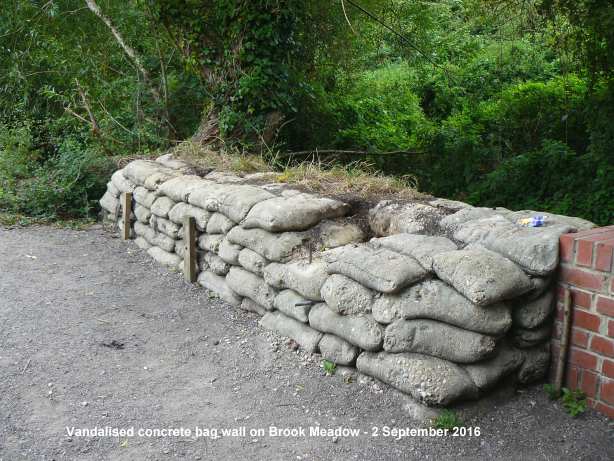
At long last the
Pepper-saxifrage on the east side of the Lumley
area is in flower. I was a bit concerned that we may
have lost this notable plant as some of them were
inadvertently mown during path cutting.
Pepper-saxifrage is one of our prized old meadow
indicators and grows only in this one spot on the
meadow.

There are lots of
fresh leaves of Amphibious Bistort with dark
blotches on them on the centre meadow where it had the
annual cut. This is the terrestrial version of
Amphibious Bistort which rarely flowers, though,
saying that, I have seen an exceptional number of
flowering plants on the meadow this year.
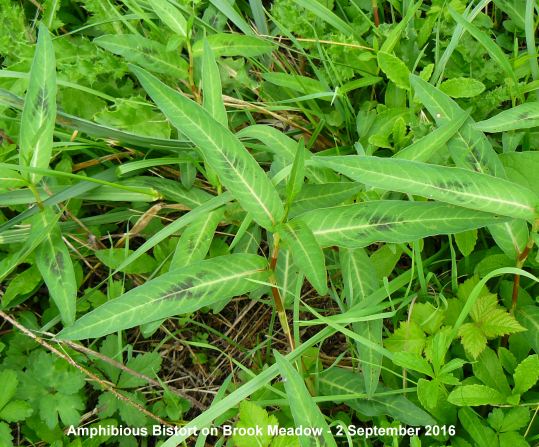
Waysides
News
The large
Weeping Willow tree that overhangs the Westbrook
Stream and part of Bridge Road car park was lopped
this morning by tree surgeons. This tree is in a
garden and the job is a private one and nothing to do
with the council, though I will check to see that the
debris does not get into the stream.
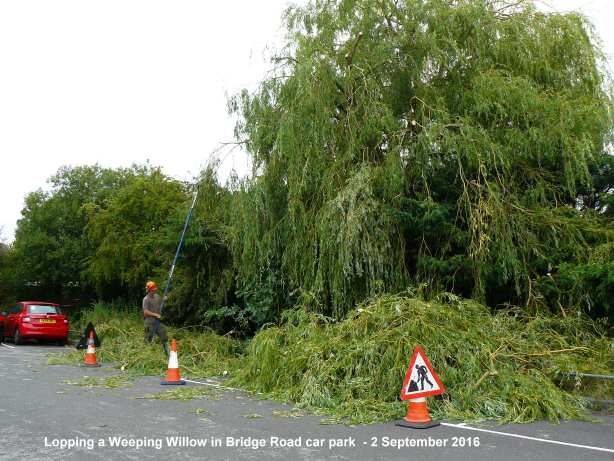
Butterfly
mating behaviour
I am grateful
to Ralph Hollins for providing the correct
interpretation of Malcolm Phillips's photo in the blog
entry for Aug 31 of two Small White butterflies
apparently mating.
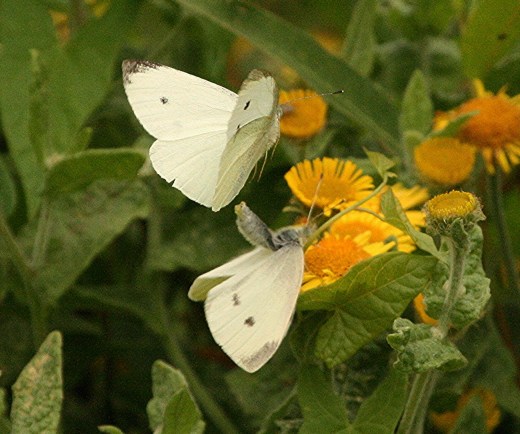
Ralph says, "I long
understood that the behaviour of the female
(flattening her wings and raising her abdomen) in
Malcolm's photo was a sign that she had already mated
and was rejecting the advances of the male (the
reverse of your interpretation). I found some
confirmation of the 'rejection' theory (plus a
suggestion that the upward pointing abdomen was
squirting some anti-aphrodisiac towards the male) in a
website at . . . http://21stcenturynaturalist.blogspot.co.uk/2012/05/rejection-courtship-behaviour-in-orange.html
Ralph says, Skip the first paragraph but read the
second paragraph (and note that the third paragraph
says that this same behaviour is used by unmated
females to encourage the male!!) I know this website
is talking about Orange Tip behaviour but I think the
rejection process is common to several species."
Fascinating behaviour!
THURSDAY
SEPTEMBER 1 - 2016
Nore
Barn
I nipped over
to Nore Barn in the car at about 10am to have a look
at the stream. Apart from Black-headed Gulls, the only
bird in the stream was our old friend the
colour-ringed Greenshank - G+GL.
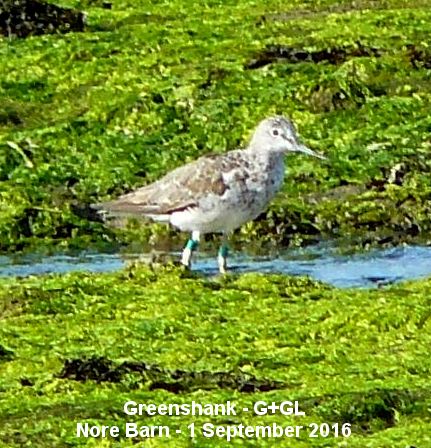
This bird was ringed
on 22-Sep-2014 by Pete Potts and his team on Thorney
Island and has been seen regularly in the Nore Barn
stream ever since. It is almost certainly the same
bird that had been a regular feeding companion to the
Spotted Redshank at Nore Barn for several years before
its ringing.
As for the Spotted Redshank, this remarkable bird
usually arrives by the beginning of October, though
its arrival date has been getting earlier over the 12
years that it has been with us. Last year it was
present on Sep 27. So, fingers crossed!
I was interested to
see the field to the north of the woods, which I
assume is designated for housing development, covered
in Prickly Sow-thistle going to seed. Quite a
spectacle! I had a quick look just in case there were
any interesting arable weeds around the edge, but I
could see nothing special. The Nore Barn volunteers
had been busy cutting back trees along the path to the
north of the woods.

Butterflies
Malcolm
Phillips was on Brook Meadow as usual this morning and
got some interesting images of butterflies.
Firstly, here are two contrasting Green-veined
Whites. The summer brood always has heavily marked
upper wings. The male on the left is showing its
veined under wings and the single spot on the
forewing. The female on the right is showing only the
upper wings, but each having two spots on the
forewings.
For
earlier observations go to . . . August
1-31